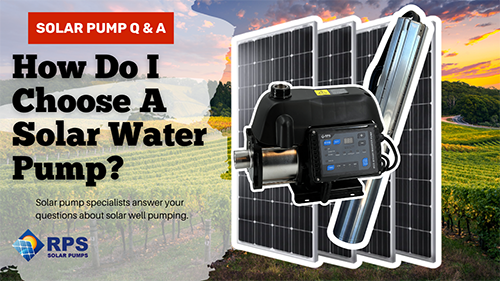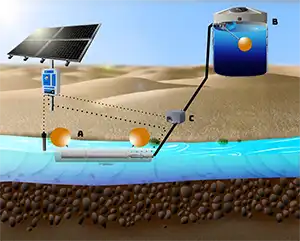How Do I Choose A Solar Pump?
Today’s question is, “How do I choose a solar pump?” When choosing the appropriate solar pump, the first thing we’re going to look at is the size of the pump you need. That’s going to be determined by the amount of water you need, either gallons per minute or gallons per day, and then your pumping head and whether we’re going to have to account for some pressure in that pumping head.
Don’t worry, we have a video on that, which goes over the details and how you’re going to size your solar pump. The next thing we’re going to look at is exact application. If you’re going down a well, obviously you’re going to have to do a submersible pump that goes down to the bottom of the well and pushes the water up and out. Now if you’re doing a surface pump application, then we have a couple of different options.
Sometimes we’ll take that same submersible pump and we’ll put it in the water source whether that’s a lake, a pond, a stock tank whatever you’re pumping out of. We’ll put that submersible pump in there, but there are other options where we do a surface pump.
These are much more popular where we’re doing sprinklers, maybe pressurize systems out of a tank. A lot of times, if you’re pumping out of a storage tank, we’re going to take a surface pump and put it down next to the tank. Then we’re going to plumb that all together. It’s really nice because we’re going to have positive pressure and that’s really common when we’re going into sprinklers or other pressurized systems.
There are other times where we need to pump a large pumping head up to the top of a hill from one storage tank to another. In those cases, we might take the submersible pump with a high head pump end on it and put that down in the tank and be able to [ump from one tank say 500 ft vertically to 1,000 vertical feet. We don’t also require positive pressure, like we get out of a storage tank. You can also pump out of another water source like a pond or a lake. In this instance, we run a suction line and a foot valve up to a surface pump and those surface pumps are capable of anywhere from 10 to 20 vertical feet of suction. Then we can suck water out of our water source, whether a pond, a lake, or a tank and then pump it to wherever we need to go whether that’s sprinklers or pressurized system.
There are also solar powered air pumps. So, instead of pumping water through a fountain in order to get oxygen into your lake, they pump the air directly down into a diffuser disc at the bottom of the lake. This has two great benefits. First, it helps mix up the water and helps eliminate thermoclines, getting colder water up to the surface and warmer water from the surface down to the bottom. It also increases oxygen levels in your lake or pond. With advancements in solar pumps these days, if you have a water pumping application, there is a solar-powered solution that’s right for you.



